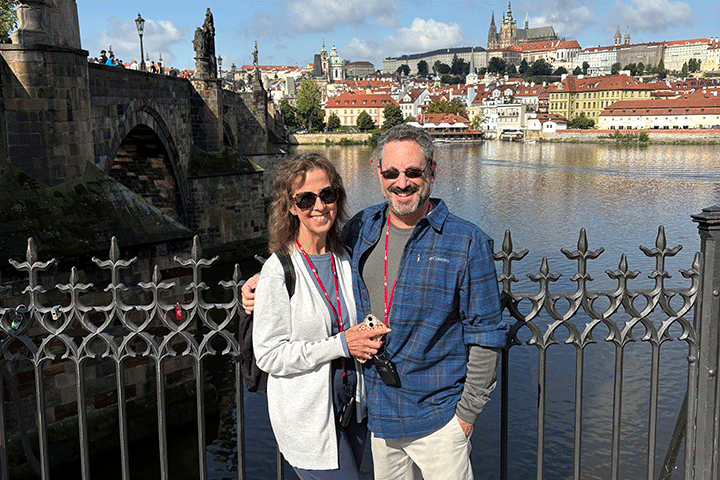Pancreatitis and Pancreatic Cancer

- Pancreatitis surgery finds pancreatic cancer
- Treatment with FOLFIRINOX
- Maintenance with fluorouracil
My journey began in February of 2021 when I developed severe abdominal pain, which turned out to be an infection.
After tests including ultrasounds, CT scans, X-rays, an MRI scan, and many blood tests, I was diagnosed in mid-March with pancreatitis. The pancreatitis was in the tail of my pancreas and had leaked enzymes, causing infection and abscesses on my left kidney and psoas muscle. I had an ERCP and placement of a stent in my pancreas at that time and the brushing of my pancreatic duct indicated a 90 percent possibility of cancer. Four days later the ERCP had to be repeated with placement of a larger stent. They took another brushing and 10 biopsy samples, which all came back negative for cancer.
Going for Treatment
I was being treated at the UnityPoint Hospital in Rock Island, Illinois, until mid-March. When they determined there was a possibility I might have cancer, they decided to send me to the University of Iowa Hospital (Iowa City).
Once the pancreatitis receded, necrosis was found in the middle of my pancreas. The oncology surgeon decided to do surgery quickly and in mid-May I went under the knife. Dr. Carlos Chan, my surgeon, removed the back two-thirds of my pancreas, my spleen, and 13 lymph nodes.
On June 8, I was informed the pathology after the surgery found a 1.8 cm mass (adenocarcinoma) in the part of my pancreas that was removed, although my lymph nodes and spleen were clear. They labeled it stage I and we were hopeful. But another CT scan at the end of June showed a new 1.9 cm lesion on my liver. The doctors changed my disease to stage IV pancreatic cancer and we began treatment with FOLFIRINOX.
I met with an integrative therapy doctor, who suggested taking the supplement turkey tail mushroom as it appears to help the chemo work better without interfering with anything.
My side effects have been mild to moderate: nausea, constipation, lightheadedness, some minor hair loss, fatigue. All were manageable with or without—depending on the side effect—the medications I was given to address them.
We did genetic testing to look for the mutations, but the mutations I had were not the ones that could be targeted. At the time, my oncologist told us I had one year, maybe three, if I was lucky.
My Current Status
The CT scans in October and December both showed almost complete resolution of the lesion in my liver. The Signatera test (a specialized test that can help determine the concentration of cancer molecules in my blood) from both those times also could not detect any circulating cancer cells even though it indicated 1.34 molecules per ml back in June 2021. My oncologist, Dr. Chandrikha Chandrasekharan, removed the oxaliplatin from my treatment in November 2021 and irinotecan in January 2022. I am now on the fluorouracil as a maintenance drug for now.
Dr. Chandrasekharan has been very happily surprised by the results so far.
While this has been like a brick to the forehead for me and my family, we decided that we were going to fight, we weren’t going to let the cancer control the rest of our lives. When we told the kids, 17, 14, and six at the time, we also told them that the cancer will not be what defines our family. It is not what our family story is about, it’s only a chapter. My wife has her own business and was able to arrange her appointments so she could be at every doctor appointment, test, and procedure.
We were told to stay positive by the medical professionals, but they never tell you how to do that. However, my decision to fight, to not accept my diagnosis as a death sentence, was key to learning what being positive really meant. The outpouring of support from coworkers, neighbors, friends, family, and many people we didn’t even know has been tremendous. My wife’s parents have been terrific. My mother-in-law came to stay with the kids while I was in the hospital in March and again in May when I had my surgery so my wife could be with me. She has also made the 45-minute drive to our house every two weeks to watch our youngest while my wife and I go to doctor appointments and chemo treatments. My work has been awesome, too. I’ve been able to take whatever days I need for appointments and recovery from treatments. They even helped organized a benefit for me.
I hadn’t realized the kind of community we had built around us until my diagnosis. I would suggest that you never forget to show your appreciation to those around you that truly care.






